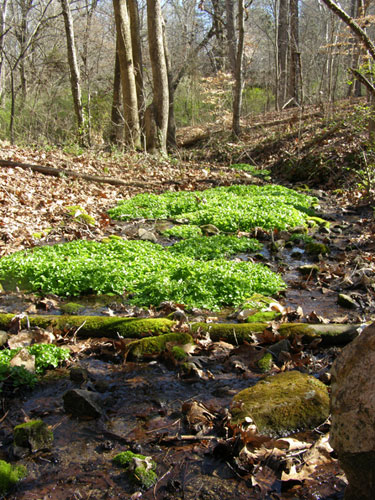Way over there in the watercress patch
By Ken Moore
Flora Columnist
Last week down in Saxapahaw during the 30th anniversary celebration of the Haw River Assembly, local musician and songwriter Tim Stambaugh excitedly said to me, “It’s watercress time again.†Tim, an enthusiastic explorer of our local nature, has been an annual visitor to a watercress patch in Battle Forest in the center of Chapel Hill.
Watercress, Nasturtium officinale, requires clear running water, something unusual these days. Though watercress is fairly common in parts of Virginia and north, it is only occasionally encountered throughout our state. I’ve seen it in the wild very few times.
Hearing about that watercress patch hidden away at the bottom of one of those Battle Forest slopes set me off searching for it with walking buddies Brian and Tony.
What a treasure to have nearby the 93-acre Battle Park with trails managed by the N.C. Botanical Garden as part of UNC. The forest of Battle Park is further extended via the Chapel Hill Greenway Battle Branch Trail connecting it to the Community Center on Estes Drive. That’s the easiest parking access to the park during weekdays, and that’s where we began our search.
It’s a 10-15 minute easy walk from there through impressive thickets of invasive exotics to arrive at one of the Garden’s helpful information kiosks where Copperhead Curve Trail crosses Battle Branch Creek.
Other entry-point interpretive kiosks are located at the Forest Theater, at the intersection of Gimghoul Road and Glandon Drive and along Park Place.
With interpretive guide and map in hand, it’s easy to marvel at the history and legend of specific points of interest throughout the forest. Having never been clear-cut, the forest contains monarch oaks, tulip poplars and American beech dating back to European settlement in 1740.
Not far from one of the dense areas of invading privet, honeysuckle and even red-berried nandina, we three were ecstatic to find that patch of emerald-green watercress.
Watercress, a perennial in the mustard family, is dependent on having its succulent stems and roots in the moving water. The watercress was nestled down in a stream close to where moving water magically emerged from beneath one of those giant trees.
We enjoyed tasting some of the tender new leaves, being careful not to disturb the base of the plants that seemed barely anchored in the streambed. The taste is distinctively spicy, unlike anything else.
My medicinal and edible-plant guru, Dr. James Duke, describes enjoying watercress up in Maryland almost all year long. He does lament, however, the reality of pollution in most streams and thus cautions about eating watercress without first cooking it. Though its spicy uncooked flavor is hard to beat, a few nights ago I really enjoyed the sweet taste of quickly sautéed watercress.
I am happy we found the watercress. Chapel Hillian Diana Steele reports knowing about that “down-in-the-woods†watercress as a youngster some years ago. Since that patch has been there for a while, I’m most proud that we three woods-walkers pulled out all the invasive Chinese privet from where, poised along streamside, it would eventually have displaced that watercress. In addition, we lingered long enough to extract a few of those encroaching nandinas.
You’ll find watercress easy to discover on Saturday mornings at the Carrboro Farmers’ Market, where at least one of the local farmers has it for observant patrons!
Email Ken Moore at flora@carrborocitizen.com. Find previous Ken Moore Citizen columns at The Annotated Flora.




Comments are closed.